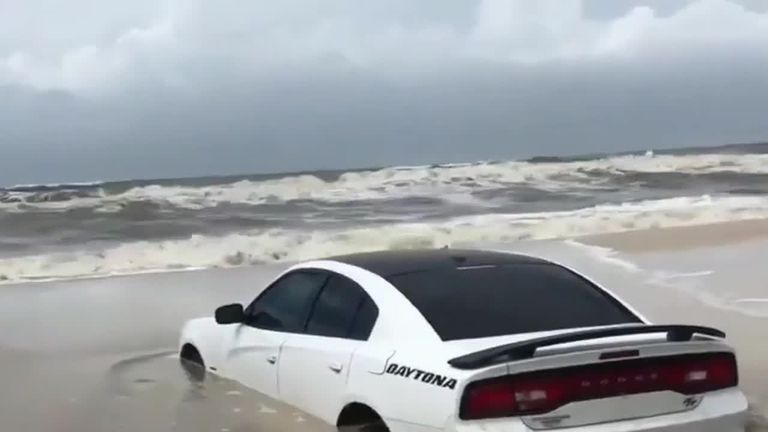Storm Barry makes landfall as US Deep South braces for more heavy rains
The storm is the first major test of flood defences that were boosted after Hurricane Katrina devastated the region 14 years ago.
Saturday 13 July 2019 21:14, UK
Storm Barry has made landfall in Louisiana and has weakened to a tropical storm after it was previously upgraded to a hurricane.
Officials have warned of a life-threatening surge of water to come with heavy rains that could last for several days.
The National Hurricane Center said the storm's winds fell to 70mph as it made landfall.
The storm is the first major test of flood defences that were strengthened after Hurricane Katrina devastated the region 14 years ago.
Barry is the first tropical storm of the season.
The heaviest rains have hit coastal Alabama and Mississippi the hardest.
Dauphin Island Mayor Jeff Collier said parts of his barrier island in Alabama are flooded from both the driving rain early on Saturday and surging water from the Gulf of Mexico.
Tourists have been trying to leave the states before the worst of the weather arrives but those who have not evacuated have been stocking up on supplies and filling sandbags.
About 3,000 National Guard troops have been deployed, bringing helicopters and vehicles capable of moving in high water.
In exposed areas of the Gulf Coast, people have been told to consider leaving their homes but residents in New Orleans have been advised to "shelter in place".
There are 1.3 million people at risk from flooding in the city area and floodgates have been closed.
Shortly before dawn this morning, more than 45,000 people in southern Louisiana had lost power.
Barry is slow-moving and is expected to arrive as a weak hurricane with winds barely more than 74mph but authorities have warned people that its real danger is in the rain.
Governor John Bel Edwards said: "Nobody should take this storm lightly just because it's supposed to be a Category 1 when it makes landfall.
"The real danger in this storm was never about the wind anyway. It's always been about the rain."
Between 10 to 20 inches (25 to 50cm) of rain could fall across parts of Louisiana, including New Orleans and Baton Rouge. Parts of the state could see 25 inches (63cm).
Some coastal roads were already under water on Friday as the heavy rain started to arrive.
Forecasters have told people in New Orleans that the Mississippi river is expected to crest there at just over 17ft - not the 19ft that had been feared. The levees protecting the city are between 20ft and 25ft.
Hurricane Katrina is estimated to have killed more than 1,800 people in 2005.
After that, New Orleans, which bore the brunt of the tragedy, invested a great deal in its flood defences.
There were repairs and upgrades to 350 miles of levees and more than 70 pumping stations and the army also started work on a hurricane protection system.












